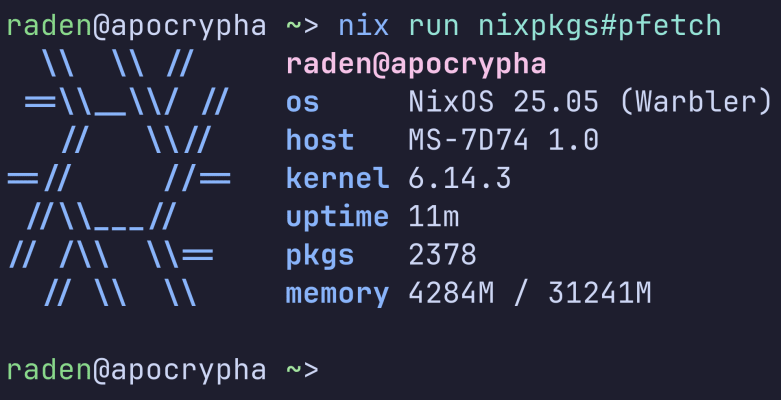
NixOS installation experience
From a `common` Linux distro to NixOS
Installing NixOS is surprisingly effortless. Both the Graphical and Minimal ISOs offer a smooth onboarding process.
If you're new to Linux terminal, I suggest starting with a graphical ISO. The NixOS graphical installer is a great option. While the Minimal ISO is ideal for advanced users, any public ISO from the NixOS download page will work for the installation process.
In this tutorial, I'll guide you through the process of installing NixOS from the Minimal ISO and creating a reproducible Nix Flake.
After booting into NixOS's Live environment, the terminal provides
instructions on how to connect to a wireless network. While this might
seem straightforward—especially since most users are familiar with
NetworkManager many "advanced" distro installations often rely on using
wpa_supplicant for wireless networks.
Before you begin, you may want to adjust the console font.
# ter-112n, sun12x22 or use the -d flag to doble the size
setfont ter-116bNote: Unlike other Linux distributions, NixOS does not expose the /usr/share/fonts/ directory.
Using wpa_passphrase
There are many ways to configure a network, but using wpa_supplicant is one of the simplest methods.
wpa_passphrase ESSID | sudo tee /etc/wpa_supplicant.confBy running wpa_passphrase, you can generate the configuration for
wpa_supplicant. Then, enter your Wi-Fi network's SSID and passphrase,
and restart the service with systemctl.
Note: To get the ESSID (Extended Service Set Identifier) run iw dev.
iw dev | grep Interface
Interface # wlp2s0, wlp12s0, wlan0..
# replace interface with your device
iw dev interface scan | grep SSID
wpa_passphrase ESSID | sudo tee /etc/wpa_supplicant.conf
#reading_passphrase from stdin
network={
ssid="ESSID"
#psk="PASSPHRASE"
psk=dd34ad23098d17da4a43fb886126a6702172563b8e1daad3d102a9c0f8ce18f7
}
systemctl restart wpa_supplicant.serviceUsing wpa_cli
This is the method recommended in the NixOS manual.
> add_network
0
> set_network 0 ssid "myhomenetwork"
OK
> set_network 0 psk "mypassword"
OK
> set_network 0 key_mgmt WPA-PSK
OK
> enable_network 0
OKPartitioning the disk
You can use cfdisk to partition the disk. For UEFI systems, make sure to select the GPT (GUID Partition Table) label type. After partitioning, you can verify the results by running lsblk.
For the root partition, use either ext4 or btrfs. One of the key advantages of btrfs is its support for subvolumes and snapshots.
mkfs.vfat -F32 -n BOOT /dev/nvme0n1p1
mkfs.btrfs -L NixOS /dev/nvme0n1p2
mount /dev/disk/by-label/NixOS /mnt
btrfs subvolume create /mnt{@,@nix,@home,@tmp}
umount /mnt
mount -o defaults,noatime,compress=zstd,commit=120,subvol=@ /dev/disk/by-label/NixOS /mnt
mkdir -p /mnt/{nix,home,tmp,boot}
mount -o defaults,noatime,compress=zstd,commit=120,subvol=@nix /dev/disk/by-label/NixOS /mnt/nix
mount -o defaults,noatime,compress=zstd,commit=120,subvol=@home /dev/disk/by-label/NixOS /mnt/home
mount -o defaults,noatime,compress=zstd,commit=120,subvol=@tmp /dev/disk/by-label/NixOS /mnt/tmp
mount /dev/disk/by-label/BOOT /mnt/bootIf you need a swapfile.
dd if=/dev/zero of=/mnt/var/swapfile bs=1G count=4
chmod 600 /mnt/var/swapfile
mkswap /mnt/var/swapfile
swapon /mnt/var/swapfile
# btrfs filesystem
btrfs filesystem mkswapfile -s 4g -U clear /mnt/var/swapfileNixOS configuration
Run sudo nixos-generate-config --root /mnt to generate a configuration file located at /mnt/etc/nixos/configuration.nix, along with a hardware-configuration module for your system.
Read the comments carefully, and be cautious when editing the hardware configuration.
configuration.nix
{
pkgs,
lib,
...
}:
{
imports = [ ./hardware-configuration.nix ];
loader = {
systemd-boot.enable = true;
efi.canTouchEfiVariables = true;
};
networking.hostName = "nixos";
networking.networkmanager.enable = true;
time.timeZone = "America/New_York";
users.users.alice = {
description = "alice";
isNormalUser = true;
shell = pkgs.fish;
extraGroups = [
"wheel"
"audio"
"networkmanager"
];
};
services.openssh = {
enable = true;
settings = {
X11Forwarding = false;
PasswordAuthentication = false;
PermitRootLogin = "no";
};
};
neovim = {
enable = true;
defaultEditor = true;
};
environment.systemPackages = with pkgs; [
wl-clipboard # wl-copy and wl-paste for copy/paste from stdin / stdout
mako # notification system developed by swaywm maintainer
];
# Enable the gnome-keyring secrets vault.
# Will be exposed through DBus to programs willing to store secrets.
services.gnome.gnome-keyring.enable = true;
# enable Sway window manager
programs.sway = {
enable = true;
wrapperFeatures.gtk = true;
};
system.stateVersion = "24.05";
}Nix Flake
To use Nix Flakes, you must enable the feature in your config.
{
nix.settings = {
experimental-features = [
"nix-command"
"flakes"
];
use-xdg-base-directories = true;
};
}{
inputs = {
nixpkgs.url = "github:nixos/nixpkgs/nixos-unstable";
};
outputs =
{ self, nixpkgs, ... }@inputs:
let
system = "x86_64-linux";
pkgs = import nixpkgs { inherit system; };
in
{
nixosConfigurations.apocrypha = nixpkgs.lib.nixosSystem {
inherit system pkgs lib;
modules = [ ./configuration.nix ];
};
};
}After the configuration is done run sudo nixos-install --flake .#<hostname>
in a shell to start the installation process.